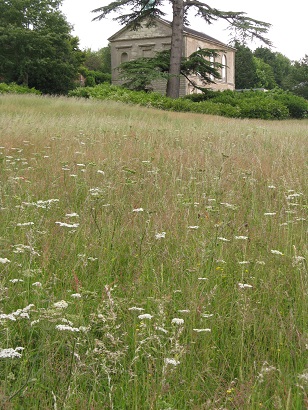Less than ten days remain to see an ephemeral work by Dan Pearson, who (and I know no one's forgotten) won this year's Best in Show at Chelsea Flower Show.

The Mown Parterre. Copyright Compton Verney Photograph by Stuart Thomas.
To accompany their exhibition, The Arts and Crafts House: Then and Now, Compton Verney, the Palladian house turned art gallery in Warwickshire, commissioned Pearson to design something for the West Lawn, where it could be seen by visitors through the windows of the galleries on the first floor and would lure them out into the wider landscape. After a summer's growth, it will look very different from the pictures below.

Dan was shown the exhibits to be included in the exhibition but given a totally free hand to design as he wished.
Having grown up in an Arts and Crafts house in Hampshire, where his mother decorated with William Morris wallpapers, he was fascinated to see the papers in the flesh. He immediately lighted on Trellis, with its balance of formality in the grid pattern and informality in the winding vines.

Visual of the Compton Verney parterre at Compton Verney. Copyright Dan Pearson Studios
Not only does it encapsulate how the best-known proponents of Arts and Crafts garden design (Edward Lutyens and Gertrude Jekyll) worked with the landscape (the formal framework provided by Lutyens' design, the informality by Jekyll's planting), but it's a rather nifty solution to what could have been an awkward juxtaposition of planting and classical facade.

"What's nice about the grid is that it takes reference from the formality of the house," said Pearson, "and then bleeds away into the trees." Thus it forms a solution to combining the formality of the Palladian villa design with an essentially informal parterre, which itself echoes more distant meadows in the landscape created by Capability Brown.

Pearson's design is a simplification of Trellis, with three large "pools" of wildflowers - Shirley poppies, corncockle, gypsophila, blue cornflowers and other colourful annuals - representing the roses in the Morris design, set in a meadow of perennials (these were not yet in bloom, thanks to the cold spring, when I visited in June). Fancifully, you can regard it as a living rendition, with the birds in the design represented by the living birds that inhabit the trees in the meadow.
"I thought I had to represent the design, rather than be slavish to it," said Pearson. "The grid works really well with the house and, without it, this would just be a meadow."
After his Laurent Perrier Chatsworth garden at Chelsea this year, winning Best in Show, this continues to demonstrate Dan's interest in blurring the edges between gardening and nature, and - as he is at his home in Somerset - gardening and agriculture.

The Arts and Crafts movement encapsulated a connection between house and garden and, indoors, the exhibition gives ample space to photos of Folly Farm in Berks. When built, it was regarded by many as the best work to come from the collaboration of Lutyens and Jekyll and the photos compare the garden as originally planted by Jekyll with Dan Pearson's acclaimed restoration, which won Historic Garden Award from the Society of Garden Designers this year. Pearson worked on it from 2009 to 2013, taking planting inspiration from Jekyll's palette, respecting the Edwardian roots, but adding more naturalism that blends the garden more into grounds and landscape.
Once you realise the affection and affinity that Pearson has for the work of Lutyens and Jekyll, it's easy to place him in the progression of garden history. "My work," he says, "is continuing in the the Arts and Crafts tradition."

The exhibition will be moving on to Newcastle but the meadow remains in a lasting legacy that Dan feels might create a versatile canvas in years to come. "Another artist can mow something else into it," he said, "It's a light-footed way to make something big and embracing."
The Arts and Crafts House: Then and Now, runs at Compton Verney until 13th September. It traces the origins and appeal of the movement through work by those such as C R Ashbee, M H Baillie Scott and Ernest Gimson, among others, looking at silverware, textiles and utensils.

Traditional tools accompanied by engravings by Stanley Anderson.
It examines iconic buildings such as Morris's The Red House and Sidney Barnsley's Beechanger, and features modern artwork and design that continue the Arts and Crafts tradition.

Porcelain vases by Andrew Wickes.


Recent Comments